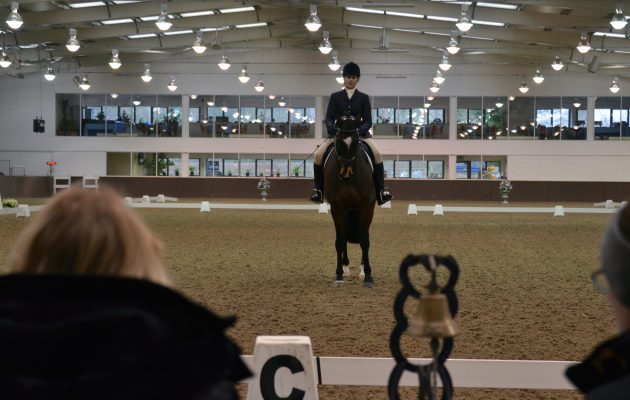We have expert training tips from Keith Robertson plus test riding tips with international judge Isobel Wessels
Hertfordshire-based dressage trainer Keith Robertson offers the following advice to work on improving these movements at home…
Session 1: canter to trot transitions across the diagonal
In prelim 17A you’re required to change the rein in canter, coming back to trot as you approach the track.
It’s important to set yourself up well for changing the rein, ensuring that your horse is attentive and listening to your aids.
Remember, the judge wants to see how straight you can perform the transition. A common mistake is to break into trot early at this level, so introduce variety in where on the line you perform the transition at home.
To try at home…
Try using your voice initially when practising your transitions, so that you’re not interfering with the balance of the canter, and then slowly fade the use of the voice out. This will mean that your horse will become used to little rein aid and therefore won’t expect you to carry him.
It’s important you get to know what to expect from your horse while you’re at home. If your horse is likely to drop the canter, leave the transition as late as possible. Conversely, if he is very bold, adjust yourself before the marker.
Work on steadying your canter while keeping your leg on, so your horse doesn’t break before trot. The tiniest amount of flexion towards the leading canter leg will help the horse find his balance and maintain roundness before the transition to trot.
When returning to the track, make it clear to the horse that you’re now remaining in trot. It’s advisable to resume rising trot so he doesn’t think he’s about to canter again. Keep him straight, don’t use too much outside leg and push him into an even contact.
You must also work on sustaining canter for longer periods of time, so the horse doesn’t learn to make a transition every time he gets to a certain point.
Keep practising riding transitions at home to help build confidence. Your horse should be ready for a transition at any time, and not be surprised.

Session 2: improving your horse’s self-carriage
Transitions are also a great way to improve your horse’s self-carriage — and good self-carriage will help push up your percentage scores.
To try at home…
You should not use your hands to create an outline, but ride the horse forward into a light contact, encouraging self-carriage.
Repeat lots of trot-to-canter and canter-to-trot transitions at home. Make sure you have the horse forward in the trot before you make the next transition and that he’s on the bit and that you’re riding him from “back to front”. Think of keeping his forehand slightly to the inside to keep him straight and avoid the hind quarters creaping to the inside — only the forehand though, don’t bend the neck.
Session 3: practise the whole test
It’s now time to practise riding the test as a whole, but first watch this test riding video with Isobel Wessels, key movements to look out for:
- Transitions across the diagonal
- Half circles returning to the track
- Transitions to medium walk
- Halting from trot
If you can not view the video player above, please click here
You may also be interested in…

Spooky horse making competing in dressage difficult? Here’s how to conquer it…
Here are some great pointers from five-star eventer Kate Honey to help you tackle spookiness with your horse in the

8 training gems from Carl Hester that could transform your dressage scores

#SundaySchool: How do I maintain impulsion in downward transitions?
Dressage rider Alice Oppenheimer explains how to keep a horse energetic and forward, even when slowing down

#SundaySchool: Dannie Morgan — how to generate impulsion without going faster
The eventer and rising dressage star explains how to generate impulsion without going faster

Why straightness is the key to effective dressage training
Most horses are born with a preference to one side. Andrea Oakes investigates how you can combat this, and the




